Best Down Jackets for Backpacking of 2024
Your insulating midlayer is a key component of your backpacking setup, and rarely is there a time when you should hit the trail without an insulation layer wedged in your pack. Here are our top picks for the best down jackets for backpacking from our gear review team, editors, and writers, as well as our tips for choosing and caring for a down jacket for backpacking. We considered features like weight, warmth, materials, and fill power to identify top-performing midlayers for every type of hiker.
Best Down Jackets for Backpacking: Quick Navigation
- Feathered Friends Eos | Best Made-in-USA Down Jacket
- Montbell Superior Down Parka | Best Value Down Jacket
- Arc’teryx Cerium Hoody | Best Down/Synthetic Hybrid Jacket
- Patagonia Down Sweater Hoodie | Best Town-to-Trail Jacket
- Rab Microlight Alpine | Best for Alpine Conditions
- Montbell Plasma 1000 Alpine Down Parka | Most Innovative Baffle Design
- Decathlon Forclaz Trek 100 Down Jacket | Best Budget Down Jacket for Backpacking
- Mountain Hardwear Ghost Whisperer UL | Best Lightweight Down Jacket
- Timmermade SUL .75 Down Sweater | Best SUL Down Jacket
Best Down Jackets for Backpacking: FAQs
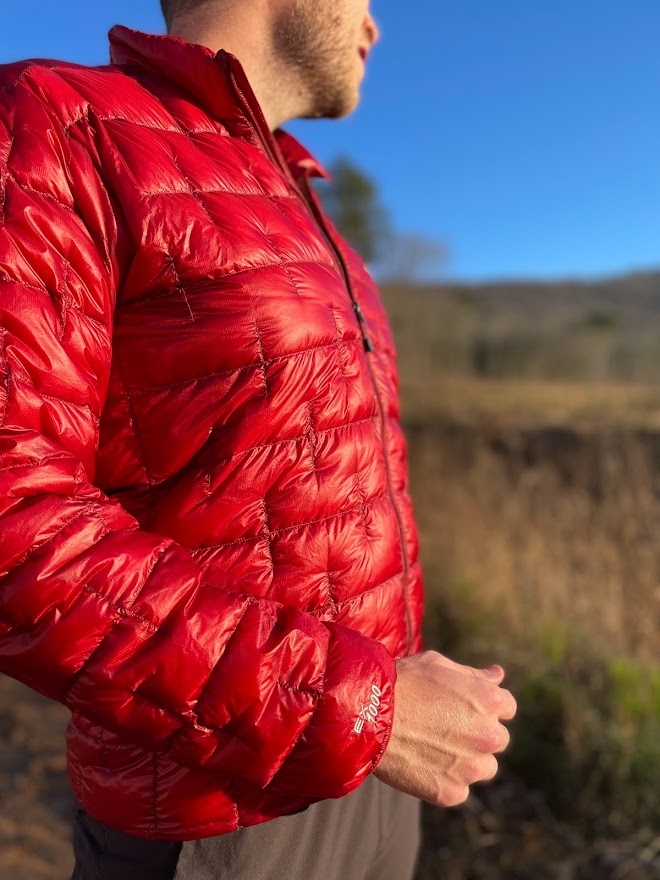
Montbell Plasma 1000. Photo: Carl Stanfield
Down vs. Synthetic Jackets for Backpacking
Insulated jackets, commonly known as puffies, are usually filled with either natural goose or duck down or with some form of synthetic polyester insulation. Both have their pros and cons. Down is much more expensive than synthetic fill and doesn’t retain loft when it gets wet. However, it is loftier on average than synthetic fill, has a better warmth-to-weight ratio, and is highly compressible.
Choose a down puffy if you’re trying to go ultralight and want superior warmth and next-to-skin softness for a fraction of the bulk.
Choose synthetic if you’re on a budget or anticipate needing your jacket a lot in wet conditions.
Choosing a Down Jacket for Backpacking
Beyond a few basic recommendations (listed below), your down jacket choice is up to personal preference. For fit, aim for a slim-to-medium style to save weight and bulk. This middle-ground sizing allows the jacket to be layered over base layers as well as under rain gear.
As far as fill weight goes, consider if you run warm or cold, and the climates you’ll be hiking through. Will you be spending multiple nights camped in the alpine zone? Hiking through chilly shoulder seasons? Opt for a heftier option. You can always send it back or trade it out if it’s too much.
Remember that you will occasionally be hiking in this layer, so it should allow freedom of movement without being too bulky and leaving excess air space to heat up. Keep durability in mind as well. If this is your thru-hiking puffy, you’ll want the insulation and face fabric to have some protection against dampness, as well as some level of abrasion resistance.
The Best Way to Care for Your Down Jacket
This layer will spend a lot of time smushed into your pack. Take it out of your pack during breaks or on town days, shake it out, and let it air dry in the sun. This will help keep the insulation lofted (maintaining insulating properties) and prevent clumping.
Launder it at least once per season with down wash in a front-loading washing machine (the agitators of top-loading machines don’t always play nice with delicate gear), then tumble dry on the lowest setting with a few tennis balls to re-loft the down.
Some down jackets have a durable water repellent (DWR) coating on the shell fabric, which helps protect the insulation from moisture. This coating will wear off over time, but you can use an after-market treatment to re-up the jacket’s DWR coating.
Avoid sweating in your down jacket or wearing it without at least one layer of clothing between it and your skin, as body oils can reduce loft over time. Down doesn’t like getting wet–it makes it clump—so keep your jacket in a waterproof bag inside your pack during rainstorms.
Budget-Friendly Down Backpacking Jacket Recommendations
Why are down jackets so soul-crushingly expensive?
You can read more about our number-one budget down puffy pick below (spoiler alert, it’s the Decathlon Forclaz Trek 100), but our list definitely skews toward more expensive/higher-end puffies.
It’s a list of the best down jackets on the market, and we think our picks truly are the cream of the crop — but for those who don’t need the cream of the crop, just a half-decent puffy to keep them from freezing during their thru-hike, here are a few more budget recommendations. Bide your time and shop the sales for even better prices.
Also, check out our list of the best synthetic jackets for backpacking; synthetic insulation is much less expensive than down, but it’s also heavier.
- REI Co-op 650 Down Jacket Men’s | Women’s
- $130
- Costco down jackets
- Costco occasionally stocks name-brand down puffies for mind-boggling prices (often less than $50); can’t predict what they’ll have and when, but if you have a membership it’s worth keeping an eye on their online inventory
- Uniqlo Ultra Lite Down Parka Men’s | Women’s
- $90
- Eddie Bauer Cirruslite Down Jacket Men’s | Women’s
Features to Look For in the Best Down Jackets for Backpacking

These are simply guidelines but should narrow down a pretty packed field.
Weight: Under 14 ounces.
Fill power: At least 750 fill.
Percent fill: Weight of down divided by weight of total garment = percent fill. The higher the better.
Treatment: Treated down may protect your insulation, as will a DWR-treated shell. Different brands have varying names for their treatment for both insulation and fabrics. However, some feel that treating down doesn’t improve its performance enough to be worth it.
Pockets: Should be placed high enough to be accessible under a hip belt. Zippered side pockets are best; a chest pocket doesn’t hurt either.
Hood: Optional, but a hood is nice as it prevents drafts from blowing down the back of your neck. Increases warmth, weight, and price.
Ethics and sustainability: Look for recycled materials in the shell fabric, PFC-free DWR treatments, and Responsible Down Standard (RDS)-certified down.
Here are our favorite down jackets for the year, specifically for backpackers. They have a variety of fits, fill powers, and features, but are all lightweight, warm, and packable for long treks.
-Maggie Slepian
Best Down Jackets for Backpacking of 2024
Feathered Friends Eos Men’s | Women’s (Best Made-in-USA Down Jacket)

Best down jackets for backpacking: Feathered Friends Eos.
MSRP: $409
Total Weight: 10.8 ounces men’s | 10 ounces women’s
Fill Weight: 4 ounces men’s | 3.7 ounces women’s
Percent Fill: 37 percent men’s | 37 percent women’s
Fill: 900-plus-fill goose down
Size range: XS – XXL
This light, super packable jacket from the Seattle-based company is as versatile as it gets. It can layer over or under, is packed with insanely lofted 900-fill down, and is made in Canada and the US. The fit is slimmer than others on this list, so keep that in mind when figuring out sizing. It works well as an active layer and doesn’t feel bulky under a pack.
We’ve long wanted to see a chest pocket or an inner pocket on the Eos, and in 2022 Feathered Friends delivered with the addition of both a chest pocket and an adjustable drawstring component on the jacket’s deep hood. These updates, combined with durable Pertex Quantum face fabric and 3.7 ounces of premium-quality down, give this jacket top marks. –Editors
Note: The Eos is frequently out of stock, so if you’re looking to add this to your collection, just sign up for the notification.
Materials and Features
Feathered Friends is famous for thoughtful designs, premium materials, and outstanding attention to detail. The Eos is no exception. 3.7 ounces of extra-fluffy 900+ fill down give this jacket plenty of loft and warmth, while the windproof, 20D Pertex Quantum nylon exterior provides durable protection and water resistance thanks to a DWR finish.
Unlike most jackets, the Eos uses Lycra, rather than elastic, to seal out drafts at the cuff. The jacket also features an adjustable hood and hem and two zippered hand pockets. As of last winter, the Eos also has a handy (and very cunningly concealed) zippered chest pocket.
Pros: High-quality down; deep, adjustable hood; warm; windproof; chest pocket; made in the USA.
Cons: Frequently sold out; expensive; slim fit makes layering tough.
For a similar made-in-US ultralight down jacket, check out the Western Mountaineering Flash hooded down jacket.
Montbell Superior Down Parka Men’s | Women’s (Best Value Ultralight Down Jacket)

Best down jackets for backpacking: Montbell Superior.
MSRP: $249
Weight: 8.6 ounces men’s | 7.3 ounces women’s
Fill Weight: 2.5 ounces men’s | 1.9 ounces women’s
Percent Fill: 29 percent men’s | 26 percent women’s
Fill: 800-fill down
Size range: S – XL
The Montbell Superior Down Parka is one of the best values for a down jacket—$249 for an 800 fill-power down jacket with hood and pockets that weighs 7.3 oz. Basically, it’s the Ghost Whisperer, but more than $100 cheaper. The square baffles keep the down in place, and the high collar protects from drafts. I’ve also had the Montbell Plasma Jacket, which is lighter and more expensive, but the Superior Down Parka is more versatile. –Megan McGowan
Materials and Features
Two-and-a-half ounces of 800-fill down and ultralight 10D ripstop nylon shell fabric keep the weight down in the Superior Down Parka. The quilting pattern stops down migration in its tracks, but we’re leery of all those extra seams, which can create cold spots and also represent potential future failure points. The jacket features an adjustable hood and hem, elastic cuffs, and two zippered side pockets.
Pros: Great price for the weight and quality; quilting functionally eliminates down migration.
Cons: Lots of sewn-through seams reduce warmth and durability; not a whole lot of insulation (functionally limited to mild conditions).
Arc’teryx Cerium Hoody Men’s | Women’s (Best Down/Synthetic Hybrid)

Best down jackets for backpacking: Arc’teryx Cerium.
MSRP: $400
Weight: 11.8 ounces men’s | 10.2 ounces women’s
Fill Weight (Down)*: 4 ounces men’s | 3.2 ounces women’s
Fill: 850-fill goose down/Coreloft polyester fibers
Size range: XS – XXXL men’s | XXS – XXL women’s
*Total fill weight (including synthetic) not reported
Our reviewer originally nominated the Arc’teryx Cerium SL for this list after thru-hiking the PCT with it. Sadly, that jacket is no longer widely available, but we still recommend that you check out the slightly heavier (but still awesome) Cerium. “It uses Down Composite Mapping, which places synthetic insulation in the “high use” areas (cuffs, armpits, top of the shoulders, and facial area),” wrote Carl Stanfield of the Cerium SL in 2021. “Everywhere else uses 850 fill-power goose down, which does a solid job keeping you warm out on the trail.”
The beefed-up Cerium still uses Down Composite mapping and keeps the weight reasonable at 11.8 ounces for a men’s medium while featuring a more durable 15D shell fabric.
Materials and Features
850-fill goose down supplies the bulk of this jacket’s insulation, but Arc’teryx made the ingenious move to use their in-house synthetic Coreloft insulation in the armpits, cuffs, and hood—areas that are highly vulnerable to moisture. The Cerium was upgraded to a stronger 15D ripstop nylon shell, which is stronger than the former 10D model. Yes, this jacket is expensive, but it’s surprisingly hardy—just be sure to protect it from snags.
The shell has a DWR treatment to protect it from light moisture, while the nylon liner feels buttery-soft against your skin. The adjustable storm hood snugs down well and has better coverage than most, while elastic cuffs and an adjustable hem further cut down on drafts. The Cerium packs down into a baby stuff sack that comes with the jacket. The jacket has two zippered hand pockets.
For a loftier / more durable (but substantially heavier) version of this jacket, check out the 18-ounce Arc’teryx Thorium.
Pros: Areas of synthetic fill protect against moisture damage; very lightweight and packable; great hood.
Cons: Expensive; thinner shell fabric can be prone to snagging.
Patagonia Down Sweater Hoodie Men’s | Women’s (Best Town-to-Trail Jacket)

Best down jackets for backpacking: Patagonia Down Sweater Hoodie.
MSRP: $329
Weight: 14.8 ounces men’s | 12.1 ounces women’s
Fill Weight: 5.4 ounces men’s | 4 ounces women’s
Percent Fill: 36 percent men’s | 33 percent women’s
Fill: 800-fill goose down
Size range: XS – XXXL men’s | XXS – XXL women’s
“I wore the Patagonia Down Sweater Hoodie on the PCT in 2017, and throughout numerous trips since then. I’ve had it for several years, and it still keeps me warm. It’s durable, reasonably water-resistant, and I prefer a jacket with a hood. I started the trail with a Patagonia Nano Puff and upgraded to this sweater model on trail. I also appreciate that Patagonia has responsibly sourced down and highlights sustainability.” – Alex Cremer
Materials and Features
If sustainability is a primary concern for you, Patagonia is the way to go. Their Down Sweater features 800-fill, RDS-certified, traceable goose down and a recycled, windproof 20D ripstop polyester shell with moderate water resistance via a DWR treatment.
Better yet, the jacket now contains PFC-free DWR, and a company-wide shift means that all of the company’s water-repellant products will be PFC-free by 2024 (PFCs are a class of highly persistent, toxic chemicals commonly found in DWR).
The jacket has all the usual features you’d hope for in a puffy, including two zippered hand pockets, elastic cuffs, and an adjustable hood and hem. It’s also a great choice for hikers who want style points that count with the general population and not just fellow hiker trash.
Pros: Recycled/responsibly sourced materials; no PFCs; windproof shell enhances warmth; ripstop polyester shell has more native water resistance than nylon.
Cons: Heavy; can feel under-stuffed; hood is only one-way adjustable.
Rab Microlight Alpine Men’s | Women’s (Best for Alpine Conditions)

Best down jackets for backpacking: Rab Microlight Alpine.
MSRP: $295
Weight: 16.5 ounces men’s | 14.6 ounces women’s
Fill Weight: 5 ounces men’s | 5.1 ounces women’s
Percent Fill: 30 percent men’s | 35 percent women’s
Fill: 700-fill goose down
Size range: XS – XXL
Throughout the years, Rab has consistently built durable, sleek apparel with function and fit in mind. The Rab Microlight Alpine is a mid-fit layer packed with ethically sourced down and narrow baffles.
This jacket fits well either as a mid-layer or on its own, and with intended use for alpine climbs, it packs down small and has a deep hood. It has a windproof and water-resistant face fabric (Pertex Quantum) and hydrophobic goose down, making it one of the more protected jackets on the list, ideal for hikers who might be heading into questionable conditions. –Editors
Materials and Features
700-fill goose down is far from the loftiest on this list, but it keeps the price reasonable, and a generous five ounces of fill ensures that this jacket has plenty of loft. The shell is made of durable (by ultralight standards) 30D Pertex Quantum ripstop nylon, which is windproof and, aided by a DWR treatment, water-resistant. Even if moisture does penetrate in harsh weather conditions, the Microlight’s hydrophobic down won’t be damaged and will still retain partial loft.
A close-fitting collar, adjustable wire-brimmed hood and hem, and elastic cuffs maximize the warmth of this jacket. In addition to two zippered hand pockets, the Microlight is also the only jacket on this list to feature a zippered chest pocket.
The most recent update to this jacket saw a redesigned baffle system and a boost in sustainability. While the previous version of the Microlight featured a recycled inner lining, the newest version ups the ante with recycled outer shell fabric and recycled inner lining, too.
Pros: Very warm; inexpensive for the amount of insulation it provides; hydrophobic down; windproof, durable 30D shell; chest pocket; fully recycled shell, insulation, and lining; brimmed hood.
Cons: Heavy; warmer than most thru-hikers will need; number of baffles seems excessive for the amount of fill.
Montbell Plasma 1000 Alpine Down Parka Men’s | Women’s (Most Innovative Baffle Design)
MSRP: $479
Weight: 8.4 ounces men’s | 7.9 ounces women’s
Fill Weight: 3.4 ounces men’s | 3 ounces women’s
Percent Fill: 40 percent men’s | 38 percent women’s
Fill: 1,000-fill down
Size range: S – XL
Simply put, the Montbell Plasma 1000 Alpine Down Parka is the best down jacket I’ve ever tested. It uses 1,000 fill-power down, which is borderline unheard of, weighing in at just 8.4 ounces. It’s plenty warm for three-season backpacking. And for being made with such ultralight materials, is surprisingly durable. Mine has seen over 3,500 miles of trail and is still going strong. I’ll say it again: it’s the best down jacket I’ve ever tested. –Zach Davis
Read our review of the Montbell Plasma 1000 down jacket.
Materials and Features
Montbell isn’t the only company that utilizes a discontinuous quilting pattern rather than standard tube-shaped baffle chambers, but they execute it pretty darn well: their unique quilting disrupts down migration while minimizing the number of sewn-through seams.
Ultra-premium 1000-fill down is hard to come by and boasts the best warmth-to-weight ratio around. Ultralight, DWR-treated 7D ripstop nylon shell fabric seals the deal, bringing this jacket in at a featherlight 8.4 ounces for the men’s version and 7.9 for the women’s.
Montbell also makes an almost unbelievably light summerweight version of the Plasma 1000 that weighs a scant 4.9 ounces. However, we love the Plasma 1000 Alpine for its generous 3.4 ounces of stuffing (more than 40 percent of the jacket’s total weight, as Montbell points out). This added insulation will serve thru-hikers better across a range of three-season conditions. An adjustable hood and hem, elastic cuffs, and two zippered hand pockets maximize the warmth and functionality of this jacket.
Pros: Superb warmth-to-weight ratio; very warm; quilting pattern designed to minimize down migration; good longevity if you protect it.
Cons: Expensive; very thin shell fabric will need to be babied; limited size range.
Decathlon Forclaz Trek 100 Down Jacket Men’s | Women’s (Best Budget Down Jacket)
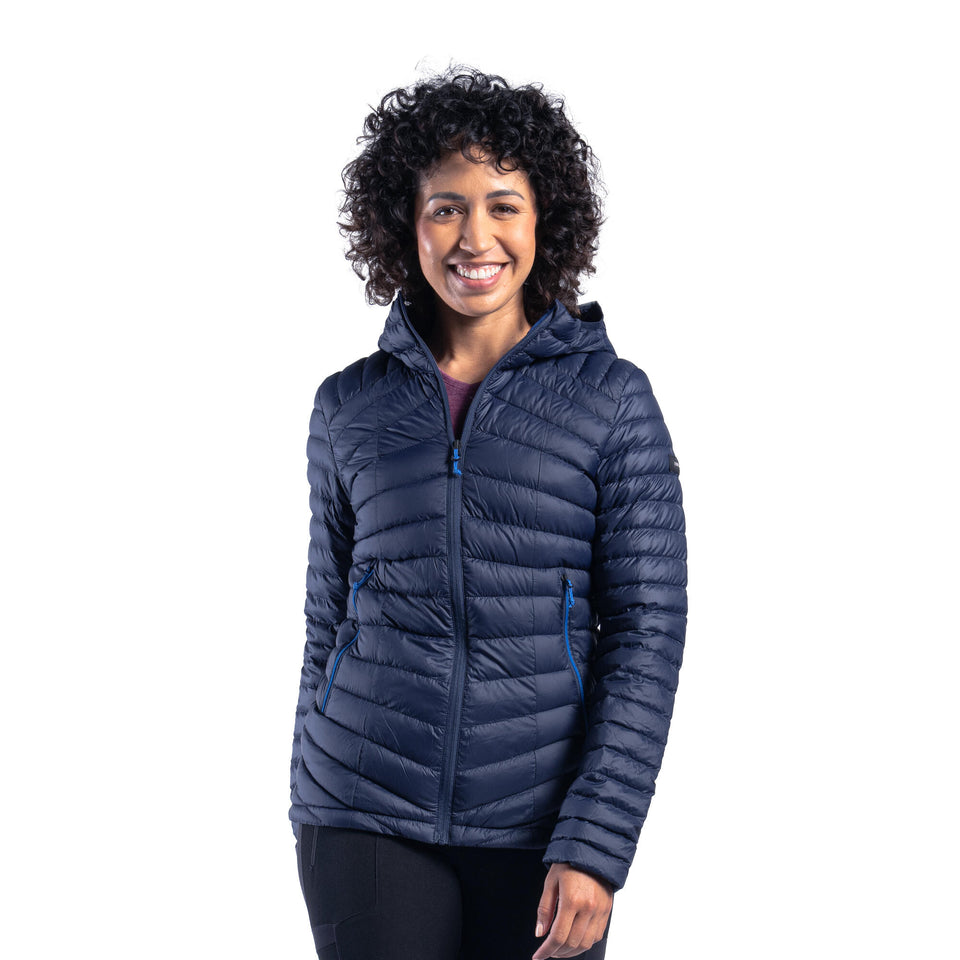
Best down jackets for backpacking: Decathlon Forclaz Trek 100
MSRP: $100
Weight: 10.4 ounces men’s large | 9.8 ounces women’s medium
Fill Weight: 3.1 ounces men’s | 3.1 ounces women’s
Percent Fill: 30 percent men’s | 32 percent women’s
Fill: 800-fill down
Size range: S – XXXL men’s | XS – XXL women’s
If you’re on a budget, it doesn’t get better than the Trek 100. It costs a fraction of the price of most down jackets, yet the weight, materials, and features are on par with the best of them. It may not be as durable as a top-shelf jacket, but it should be able to survive a thru-hike if you’re careful with it.
Even among budget offerings, this jacket stands out: it’s cheaper and lighter than the REI Co-op 650 Down Jacket 2.0, a staple among budget-conscious hikers. It also weighs less than the similarly-priced Uniqlo Down Parka and offers more transparency on the product page regarding materials and design, which, when a product seems too good to be true, helps to inspire some much-needed confidence. –Editors
Materials and Features
Decathlon supplies this jacket with a generous 3.1 ounces of RDS-certified 800-fill duck down sealed inside a 15D, DWR-treated nylon taffeta shell. The Trek 100’s insulation contains 85 percent down plumes and 15 percent feathers, better than the federal minimum standard of at least 75 percent down but below the 90 percent threshold set out by higher-end down jackets.
The jacket has two zippered pockets and an adjustable hem, but it lacks elastic cuffs or a drawcord adjustment for the hood. Decathlon says this jacket runs small, so consider sizing up to make sure you have plenty of room for layers underneath.
Pros: Inexpensive; moderately lightweight; high quality down.
Cons: Heavy; some users complain about lack of loft in arms; nylon taffeta not as durable as ripstop; no elastic cuffs or adjustable hood.
We have to acknowledge that the jackets on this list are almost all very expensive. Check out these additional recommendations for budget puffies.
Mountain Hardwear Ghost Whisperer UL Men’s | Women’s (Best Lightweight Down Jacket)

Best down jackets for backpacking: Mountain Hardwear Ghost Whisperer UL.
MSRP: $420
Weight: 7.1 ounces men’s large | 6 ounces women’s small
Fill Weight: 2.5 ounces men’s | 1.9 ounces women’s
Percent Fill: 35 percent men’s | 32 percent women’s
Fill: 1000-fill down
Size range: S – XXL men’s | XS – XL women’s
The Ghost Whisperer has long been a thru-hiker favorite and a dominant player in the ultralight puffy arena. The Ghost Whisperer UL’s gotten even lighter thanks to ultra-thin shell material and 1000-fill down insulation. Believe it or not, this isn’t actually the lightest down jacket out there in absolute terms, but we consider it the lightest jacket that’s still functional across a broad range of three-season conditions. -Editors
Materials and Features
The Ghost Whisperer UL is nearly 2 ounces lighter and $50 more expensive than its sibling, the Ghost Whisperer/2. That difference is entirely down to materials: the UL version uses 2.5 ounces of 1000-fill down and 5D ripstop nylon for the shell fabric (the thinnest material on this list), while the Ghost Whisperer/2 uses three ounces of 800-fill down and a heavier 10D shell fabric.
It’s worth noting that the UL uses virgin materials in the shell fabric, while the 2 uses more sustainable recycled materials. Both jackets feature the same DWR treatment on the face fabric, an elastic hood and cuffs (meaning the hood is snug, but it isn’t adjustable, unlike most jackets on this list), two zippered hand pockets, and a drawcord-adjustable hem.
Pros: Lightest jacket on this list; warm enough for moderate three-season conditions; fully featured despite low weight.
Cons: Expensive; uses virgin materials (unlike regular Ghost Whisperer/2); probably excessive baffles; 5D fabric is extremely thin and must be babied; limited size range.
Timmermade SUL .75 Down Sweater | Best Super Ultralight Down Jacket
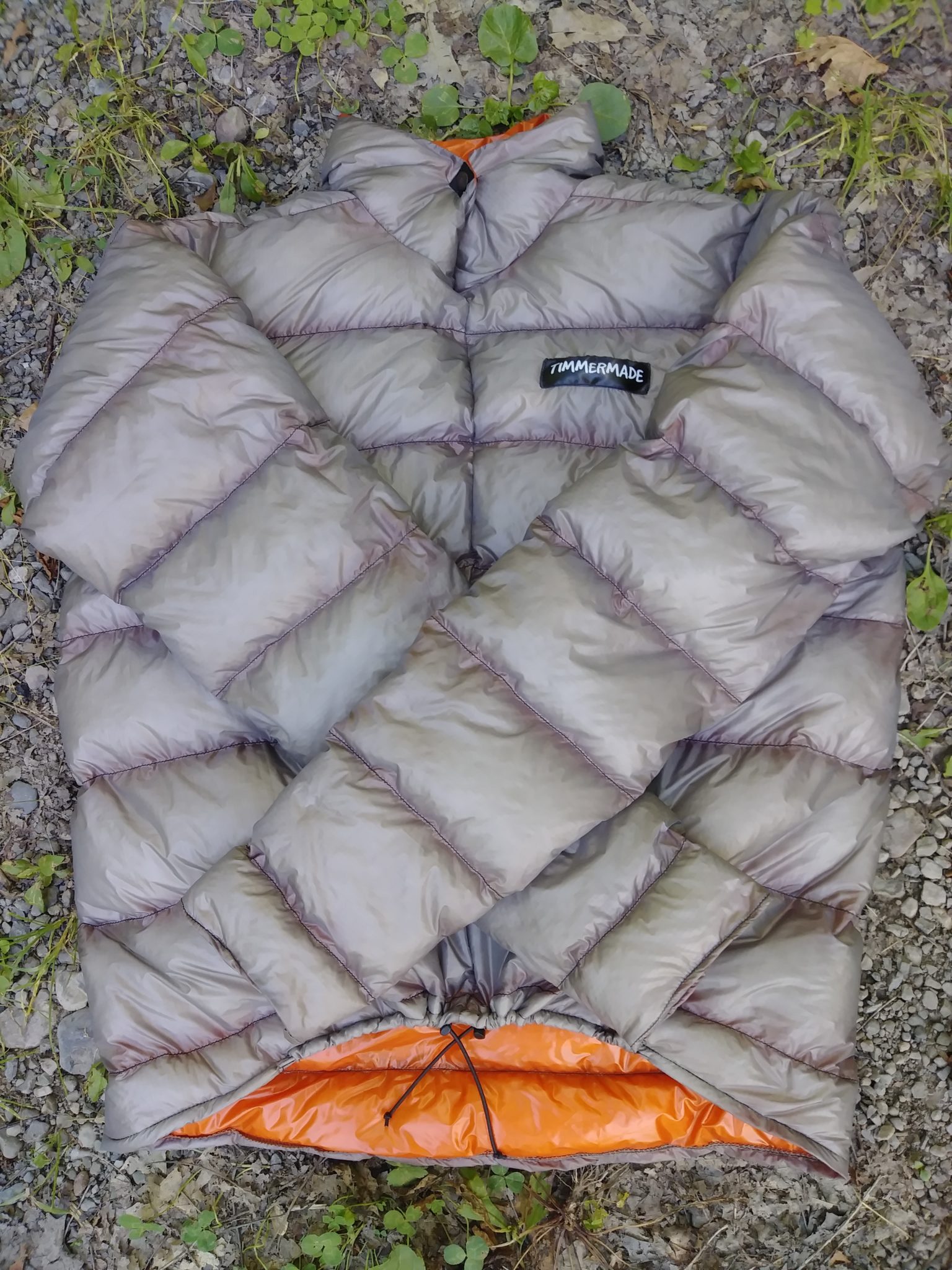
Best down jackets for backpacking: Timmermade SUL .75.
MSRP: $299
Weight: 4.4 ounces (unisex)
Fill weight: 1.8 ounces (unisex)
Percent Fill: 45 percent
Fill: 900-fill Hyperdry goose down
Size range: XS – XL (or contact Timmermade for custom sizing)
Despite its scant 4.4-ounce total weight (!!), Dan Timmerman estimates on his website that his Timmermade SUL .75 pullover puffy will keep most people warm down to freezing while inactive, “but it’s probably getting uncomfortable for most people in the 30s (Fahrenheit).” The sweater boasts a generous fill ratio: insulation accounts for a solid 45 percent of the sweater’s total weight. Besides being insanely light, the SUL sweater is also customizable for those who want a more tailored fit.
Note that there are warmer versions of this puffy. The SUL 1.1 weighs 5.6 ounces, comprises 51 percent down, and is estimated to be comfortable down to freezing—ideal for most three-season conditions. Meanwhile, the four-season SUL 1.5 weighs 6.1 ounces, comprises a whopping 61 percent down, and should keep the average human warm to below freezing. -Editors
Materials and Features
As Timmerman points out on the website, this is a sweater in the truest sense: no zippers, pockets, or liners to add weight to this efficient, streamlined garment. It’s just premium water-resistant down encased in a simple nylon shell with as few seams as possible.
Broad, four-inch baffle chambers minimize sewn-through seams (aka cold spots) throughout the garment, with the down lofting to 0.75 inches in between. You can customize every aspect of the fit, so Timmerman recommends requesting extra-long sleeves to replace the hand-warming effect of pockets if this feature is important to you.
The sweater’s simplicity also keeps the price down; $299 is a lot of money, but it’s still one of the more affordable puffies on this list while also being among the warmest. Be aware that, like with most small, made-to-order companies, you’ll probably face long wait times to get your puffy (and/or you may find yourself on a waitlist).
Pros: Excellent warmth-to-weight ratio; affordable; customizable; simple; optional hood; removable neck and hemline cinches
Cons: No zipper or pockets; long lead times
Related
Why should you trust us?
Because we’re so incredibly intelligent, of course! Attractive, too. (Not to mention extremely humble).
But if that isn’t enough to impress you, there’s also the fact that everyone who contributed to this article is an experienced thru-hiker with thousands of on-trail miles under their belt. We’re gear nerds who love putting our equipment to the test on trails long and short, and we’ve tested dozens of puffies in pursuit of cozier backcountry days.
Moreover, we do our best to stay plugged into the trail community’s gear preferences (we are definitely those obnoxious people on trail who always want to know what everyone else is packing). That means our picks for the best down jackets for backpacking aren’t just our opinions. They’re based on years of feedback from the thru-hiking community.
To all you people in the comments section: we’re listening to you too. Thanks to everyone who commented on the list. We’ve incorporated many of your suggestions and requests in the list.

Competence and backpacking proficiency personified.
Rachel Shoemaker and Alexander “GPS” Brown contributed to this list.
Featured image: Graphic design by Chris Helm.
This website contains affiliate links, which means The Trek may receive a percentage of any product or service you purchase using the links in the articles or advertisements. The buyer pays the same price as they would otherwise, and your purchase helps to support The Trek's ongoing goal to serve you quality backpacking advice and information. Thanks for your support!
To learn more, please visit the About This Site page.

 ">
">

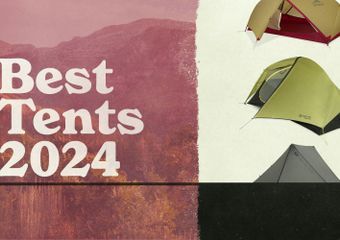
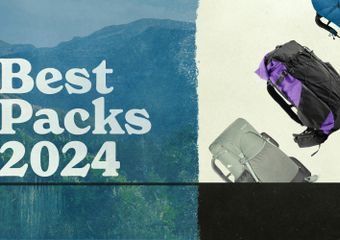
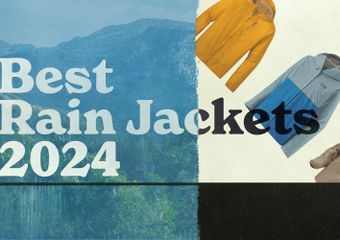


Comments 25
I have a question about the durability of the VERY expensive Montbell Plasma 1000 which I just bought and am now trying to decide whether to keep it.
It is SO light-weight that durability is a big concerns. Zach, you said that yours has been very durable. But a Montbell rep told me over the phone that he does not recommend wearing the jacket when you are hiking unless you have another layer (that is, a shell) between the Plasma 1000 and your pack.
So my question is: Did you baby your Plasma 1000 like this in order to have it last the 3,500 miles? Did you wear it directly next to your pack when it was cold, or either just use it in camp or use it under a shell as Montbell recommends?
Good question, Stephen. I sweat a lot, so I very rarely hike while wearing my down jacket. In the rare situations where I would hike with my down jacket- when it’s exceptionally cold (below freezing)- I would also pair it with my rain jacket- more so to trap body heat than preserve the down, though I suppose that is an unintended benefit.
I am careful with the piece, however, and would caution anyone using this or any piece with a thin denier to be.
Thanks, Zach. Super helpful. I’m 5’8” and about 150 lbs and the medium seems a bit roomy if I’m just going to wear it with a base layer. What size do you have if your don’t mind my asking?
Just going to throw this out there. I know its not down, and some of you will hate this, but the Amazon Essentials puffy coat is not awful. Its water resistant, packs down very small and is quite liteweight (comes with its own stuff sack) I know it is not a down jacket, but its just as warm as the Columbia puffy down coat I have except it only cost $40. Zippered pockets, proper fitment, wind resistant zipper, truly Water resistant, and a price that I could afford to spend again when something happens to it. Because something always seems to happen to a puffy coat on trail. Again, I know its not down, but it is a decent jacket. Just as good as some of the cheaper offerings listed here. I like it because I don’t overheat in it when really hiking hard. Also, they are true to size.
Just curious but why was the northface summit L3 hoody left off of this list? I’ve tried a couple of these jackets and that one was by far my favorite.
Wondering why Western Mountainering was not on this list? Great down jacket I’ve been using.
Your list is a great one, thanks!
It’s pretty messed up that this list only links to men’s gear. Way to perpetuate sexism in the outdoors.
Each jacket has a link to both men’s and women’s jackets.
Really pleased to see your reviews are including quality affordable gear choices for those of us who can’t drop hundreds on a single coat or simply want to spend wiser. I have an old GW but bought a Forclaz after seeing some youtube reviews and looking into Decathlon. True, as you note they are very forthcoming on how the gear is made and by what standards. I live in the PNW and have been seriously impressed with my Forclaz and like the reviews I too think it’s as good as my GW has been. I’ve since tried a number of their merino products and am equally impressed. I’ve become a believer that the low price is more about economies of scale with Decathlon being one of the worlds largest sporting equipment companies than about being cheaper in quality. Plus if a catch an errant spark from a camp fire I won’t go to bed crying my eyes out over a much more expensive jacket with a patch on it.
None of these jackets are in large men’s’ sizes- tall or 3XL. Eddie Bauer carries one. For backpacking, a wool base layer, a wool Pendleton or prior to being a fashion company instead of a outdoor clothing company Woolrich made good wool shirts. Now their whole line stinks. Maybe a fleece vest and a rain jacket, I have never been cold. These retailers do what Colin Fletcher dubbed-“over engineer a simple concept/ jacket with feathers inside.” Most of us aren’t in the Alaska Range or the Himalayan summits. Their marketing attempts to convince you otherwise,
Please add available sizes to your summaries of all clothing and outerwear! This is helpful to a lot of people from short to tall and from small to big! It is extremely tedious, time consuming and frustrating to have to go to each website to find what sizes a company offers an item in, just to discover that they do not make it in a fairly standard size (like xxl) or offer a petite or tall version. Thanks.
There are EIGHT best down jackets – this seems like a regular occurrence in The Trek best of articles. I’d love to know what you think the best are, but when it’s more than four I’m left feeling mostly confused by the time I read to the end.
seems crazy to me how expensive this stuff is.. I have a few puffy’s from Eddie Bauer and LL Bean. all between $80-$150 .Not sure its been a while since I bought them, but I’d remember if I spent more than that on them. They seem ok.. I xc ski, fat bike and winter hike in them in Maine .. seems like they would work on a thru hike.
Thanks for all this great information on down puffys. I wanted to mention the statement in the Patagonia Down Sweater review “but as of yet the Down Sweater still contains PFCs (PFCs are a class of highly persistent, toxic chemicals commonly found in DWR).” is not currently accurate. Patagonia no longer uses PFC’s in their DWR for this jacket. I’m guessing this review was written prior to them removing the chemical.
I like this thoughtful list. When my puffy was a jacket, I found that when it was cold enough to put it on, it was also cold enough to not have it unzipped. I upgraded to an Anorak. My Montbell anorak wins the weight contest, and I don’t miss the full zip.
Eight jackets and enlightened equipment torrid is not on the list?